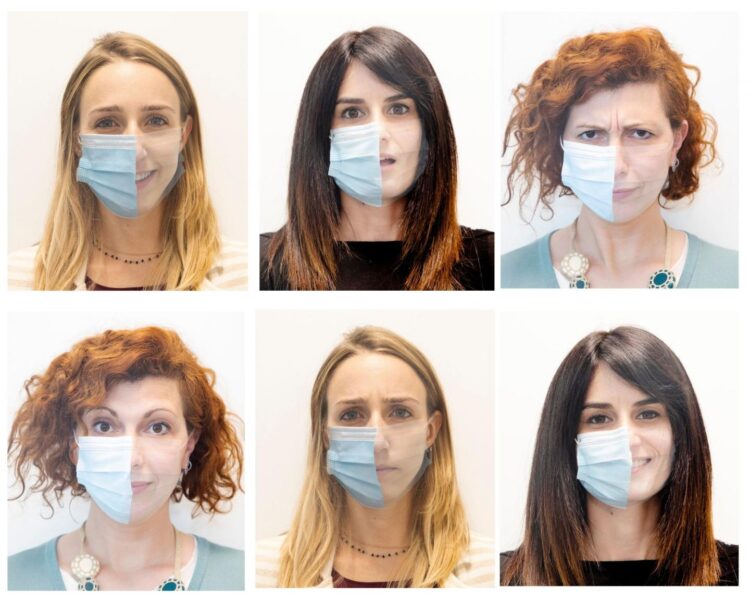The study published in Frontiers in Psychology shows that children aged from 3 to 5 years old are able to understand the emotions hidden under facemasks on just 40% of occasions.
Genova (Italy) 10 June, 2021 – The U-Vip (Unit for Visually Impaired People) research team led by Monica Gori at the IIT- Istituto Italiano di Tecnologia (Italian Institute of Technology) has recently published a study which shows for the first time how children aged from 3 to 5 years old have problems in recognising the emotions of people wearing surgical masks. This collateral effect of the preventive measures linked to the Covid-19 health emergency could influence the correct development of children’s capabilities of social interaction. The research paper has been published in Frontiers in Psychology.
The use of facemasks for children within the context of the COVID-19 pandemic was a focus of a document compiled by the World Health Organisation (WHO) and UNICEF to provide guidance for decision-makers and authorities in public and professional fields, discouraging exposure to the use of facemasks when dealing with children aged up to five years old. In addition, even for older children, WHO recommends giving careful consideration to the benefits of wearing facemasks in comparison with the potential damage that could include social and psychological problems, and difficulties in communication and learning.
The study by the IIT research team led by Monica Gori regards this context, and, for the first time it focuses on pre-school age group and it helps define the measures that can be taken to reduce the impact of the use of surgical masks amongst children. In fact, even though from 3 to 5 years of age, wearing facemasks is not mandatory, children are in any case exposed to the use of such preventive measures in various everyday social and educational contexts.
The IIT researchers prepared a quiz containing images of people with and without facemasks, and displayed them by computer, tablet or smartphone to 119 individuals comprising 31 children aged between 3 and 5 years old, 49 children between 6 and 8 years old, and 39 adults between 18 and 30 years old. The subjects, independently or with parental assistance in the case of the youngest participants, were asked to try to recognise the faces’ expressions, with and without facemask, conveying different emotions such as happiness, sadness, fear and anger.
The results showed that children aged between 3 and 5 years old are capable of recognising facial expressions conveying happiness and sadness on only 40% of occasions when the faces are covered by a facemask. The percentages were higher for other age groups: children aged from 6 to 8 years old (55-65%) and adults (70-80%) but in general, all age groups showed a degree of difficulty in interpreting these emotions expressed while the face was partially covered by a facemask. As regards the other emotions, there were better results, but we can say that the age group that finds it hardest to recognise emotions expressed from behind a facemask is that of children in pre-school age.
“The experiment was performed in the earliest phases of the 2020 pandemic, and at that time facemasks were still a new experience for everyone.”, comments Monica Gori, “Children’s brains are highly flexible, and at the moment we are performing tests to ascertain whether children’s understanding of emotions has increased or not”, concludes Gori.
“In the study, we worked with children and adults with no forms of disability”, explains Maria Bianca Amadeo, IIT researcher and co-author of the research study, “of course, these observations are even more important when considering children affected by disabilities”. “Indeed”, explains Lucia Schiatti, IIT researcher and co-author of the study “for example visual impairment implies difficulties in social interaction. For such individuals in particular, it will be even more necessary to concentrate on possible preventive measures or specific rehabilitation activities”.
Over the next few years, it will be essential to perform work designed to explore the actual impact of this preventive health measure on children’s ability to interact, both those affected by disabilities and those without disabilities.
In the meantime, the IIT study suggests considering the use of transparent facemasks for all operators in contact with children in the 3-5 year-old age group, or the formulation of specific training activities designed to teach children how to recognise emotions purely through observation of the eyes.
###
Additional information
Monica Gori
Monica Gori is tenure track researcher leading the Unit U-Vip: Unit for Visually Impaired People at the Istituto Italiano di Tecnologia. Monica Gori is an expert of development, multisensory integration, rehabilitation, cortical plasticity and visual disability. The impact of her work on the scientific community can be summarized by 130 international papers, 5 book chapters, and many conferences’ abstracts. She was the scientific coordinator of two large European grants, ABBI (http://www.
Istituto Italiano di Tecnologia
Istituto Italiano di Tecnologia (IIT – Italian Institute of Technology,) is a scientific research center established by law in 2003 by Italian Ministry of Education, University and Research and Ministry of Economy and Finance, in order to promote excellence in both basic and applied research and to facilitate the economic development at national level. IIT scientific activities started in 2006, they are multidisciplinary and with a very strong approach to technology transfer. IIT staff is of 1700 people, the majority of which (about 81%) is dedicated to research, and an average age of 36 years. About half of the researchers come from abroad: 34% are scientists from more than 50 foreign countries and 16% are Italian researchers who have come back to Italy after a professional experience abroad. IIT has a vast experience in managing and supervising research projects with a portfolio of more than 450 external funded research projects, also financed by EU funding programs and European Research Council (ERC). IIT has produced more than 14500 publications and 294 inventions; its research activity led to the creation of 24 spin-offs, with additional 30 under due diligence. Research is carried out in the Central Research laboratory in Genoa (IIT headquarters), in 11 research satellite centers across Italy and in 2 outstations in US. IIT scientific vision is interdisciplinary, based on the concept of “translating evolution into technology”, that is mimicking natural solutions to develop new technologies in the fields of robotics, materials science, and life science. Currently IIT is conducting its new scientific plan (2018-2023) developing four strategic research domains: Robotics, Nanomaterials, Technologies for Life Science, and Computational Sciences. The main goal is to produce technologies that will have a positive impact on some important societal challenges, such as sustainability and the environment, healthcare and aging society, also reflecting the priorities of EU framework programs.
Media Contact
IIT’s Foreign Press Office – Valeria delle Cave
[email protected]
Related Journal Article
http://dx.





